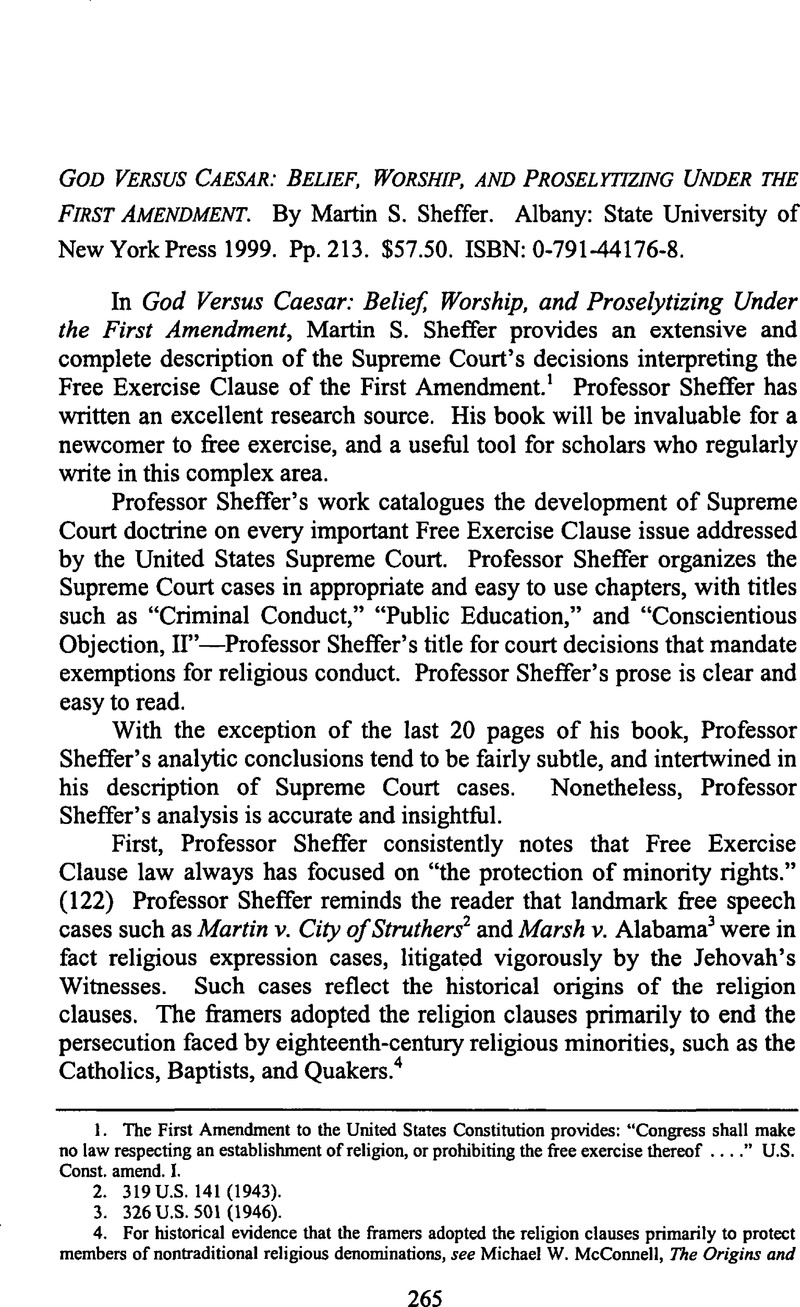No CrossRef data available.
Article contents
God Versus Caesar: Belief, Worship, and Proselytizing under the First Amendment. By Martin S. Sheffer. Albany: State University of New York Press1999. Pp. 213. $57.50. ISBN: 0-791-44176-8.
Published online by Cambridge University Press: 24 April 2015
Abstract

- Type
- Review Essays and Reviews
- Information
- Copyright
- Copyright © Center for the Study of Law and Religion at Emory University 2000
References
1. The First Amendment to the United States Constitution provides: “Congress shall make no law respecting an establishment of religion, or prohibiting the free exercise thereof. …” U.S. Const, amend. I.
2. 319 U.S. 141 (1943).
3. 326 U.S. 501 (1946).
4. For historical evidence that the framers adopted the religion clauses primarily to protect members of nontraditional religious denominations, see McConnell, Michael W., The Origins and Historical Understanding of Free Exercise of Religion, 103 Harv. L. Rev. 1409, 1437 (1990)CrossRefGoogle Scholar (many of the proponents of the Free Exercise Clause “were members of the most fervent and evangelical denominations in the nation”); Steinberg, David E., Gardening at Night: Religion and Choice, 74 Notre Dame L. Rev. 987, 1021–1023 (1999)Google Scholar (describing the religion clauses as a reaction to state persecution of religious dissenters).
See Steinberg, David E., Religious Exemptions as Affirmative Action, 40 Emory L.J. 77, 114–117 (1991)Google Scholar (arguing that the protection of minority religious groups is a central purpose of the religion clauses).
5. Tushnet, Mark, Of Church and State and the Supreme Court: Kurland Revisited, 1989 S. Ct. Rev. 373, 381, 382Google Scholar. Professor Tushnet's concerns about insensitivity to unfamiliar religious traditions may be a bit overstated. Small sects occasionally have won major free exercise victories. See Church of the Lukumi Babalu Aye v. City of Hialeah, 508 U.S. 520, 533-547 (1993) (striking down a Hialeah, Florida ordinance, which barred ritual animal sacrifices performed by members of the small Santeria religion).
Nonetheless, ample evidence supports Professor Tushnet's basic observation that courts often will discount unfamiliar religious traditions. See e.g. Steinberg, Religious Exemptions supra n. 4, at 111 & n. 205 (summarizing court acquiescence in the nineteenth-century persecution of Mormon Church members).
6. For a powerful advocacy of this approach, see generally Marshall, William P., Solving the Free Exercise Dilemma: Free Exercise as Expression, 67 Minn. L. Rev. 545, 546 (1983)Google Scholar (suggesting that courts should review free exercise claims “according to a free expression analysis, and not an independent free exercise analysis”).
7. See Marshall, William P., In Defense of Smith and Free Exercise Revisionism, 58 U. Chi. L. Rev. 308, 319 (1991)CrossRefGoogle Scholar (“Granting exemptions only to religious claimants promotes its own form of inequality; a constitutional preference for religious over non-religious belief systems.”); West, Ellis, The Case Against a Right to Religion-Based Exemptions, 4 Notre Dame J.L. Ethics & Pub. Policy 591, 600 (1990)Google Scholar (asserting that court-mandated religious exemptions provide “special or favored treatment” to some believers “because of their religion”).
8. See e.g. City of Boerne v. Flores, 521 U.S. 507, 534-535 (1997) (a generally applicable law typically will not violate the First Amendment, even if the law conflicts with an important religious tenet); Empl. Div. v. Smith, 494 U.S. 872, 882-890 (1990) (Oregon could punish Native American believers for possessing peyote, even though the believers used peyote in religious rituals).
9. Sweet, William Warren, Religion in Colonial America 131–132 (Scribner 1942)Google Scholar.
10. Cobb, Sanford H., The Rise of Religious Liberty in America 112 (Johnson Reprint Corp. 1970) (originally published 1902)Google Scholar.
11. See Madison, James, Memorial and Remonstrance Against Religious Assessments, in The Writings of James Madison 183 (Hunt, Gaillard ed., 1901)Google Scholar.
12. Resolution of July 18, 1775, in 2 Journals of the Continental Congress 1774-1789, at 187, 189 (Worthington C. Ford ed., 1905).
13. See Steinberg, David E., Rejecting the Case Against the Free Exercise Exemption: A Critical Assessment, 75 B.U. L. Rev. 241, 261 (1995)Google Scholar (“limiting the substantive protection of the Free Exercise Clause to religious expression seems arbitrary”).
14. Empl. Div. v. Smith, 494 U.S. 872, 882-890 (1990) (the Free Exercise Clause does not require that Oregon must exempt Native American believers from a state criminal law, which prohibited the possession of peyote).
15. See Church of the Lukumi Babalu Aye, Inc. v. City of Hialeah, 508 U.S. 520, 533-547 (1993) (invalidating a municipal ordinance, which sought to prohibit ritual animal sacrifices).


